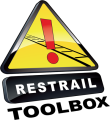22.1 Education at school dedicated to risk and safety
This measure consists of various actions and educational tools that are used in schools, separately or jointly, to teach the pupils about the danger of the rail tracks: lessons, educational tool kits, thematic school calendars, or communication specifically aimed at teachers.
- Ask education experts for help.
- Differentiate between different age categories. E.g. 4-10 year olds are more likely to play or to tinker and 11-16 year olds are more likely to work with modern media as computers and games. So the education should be prepared to these aims.
- Always test your means before using it broadly.
- Try to make your offer to schools as interesting as possible, they mostly can choose between several offers and don’t have too much spare time in their lessons program.
- Try to involve the regular teacher and not only people from railway undertakings or infrastructure managers. When you use the latter, make sure, they have been provided with educational background.
- Try to find partners to combine your lessons, E.g. in The Netherlands the lessons are given in cooperation with the organisations which give lessons to improve traffic safety.
- Various educational tools can be used, separately or jointly: lessons, communication specifically aimed at teachers, educational tool kits, thematic school calendars, etc.
- Training for people involved in the campaigns: communication staff, communication agencies, teachers, police when it is associated to the campaign.
- Storytelling can be used to target children’s pedestrian safety attitudes around railways.
- Decline of effect expected; needs to be repeated for durable effect.
- May be difficult to implement formally, because it needs mandatory approval from the school management and occasionally from the Ministry of Education.
- Should be associated to other measures such as more general communication campaigns. School oriented measures appear to be often associated to more general communication campaigns, using posters in stations or mass media.
- INFRABEL developed a free educational programme (only available in French or Dutch) intended primarily for secondary school teachers who want to discuss rail safety with their students (ages 12 -18). The programme consists of an escape game and a theory course which allow young people to assimilate in a fun way the rules to be followed.
- Education at school concerning the dangers of walking on or across railway tracks was supported by 36.5% of respondents (people living close to a railway line) (Silla & Luoma, 2012b).
- A significant effect has been reported in combination with other measures (Lobb, Harre & Suddendorf, 2001): Fencing combined with warning signs, posters and education at school: the rate of trespass decreased substantially (from 59% to 40%) and the decrease was sustained and even greater three months later (from 40% to 36%).
- Education significantly improved the amount of reported safe crossing compared to unsafe crossing, with no age effects. It raised awareness towards trespassing being illegal and significantly reduced trespass behaviour (Lobb, Harre, & Terry, 2003).
- Horton (2009) showed globally that the association between Education & Enforcement is efficient.
- Education for pupils at schools was tested by VTT in 5 schools situated close to railway lines in Finland as part of RESTRAIL pilot tests conducted in 2014. Read more in this magazine article and in the scientific publication.
- A narrative (storytelling) intervention in intermediate school students resulted in the participants reporting being less likely to undertake certain risky behaviours and reporting that they believed these behaviours to be less safe (MacArthur-Beadle, 2022).
last update: 2023-02-01 Print

